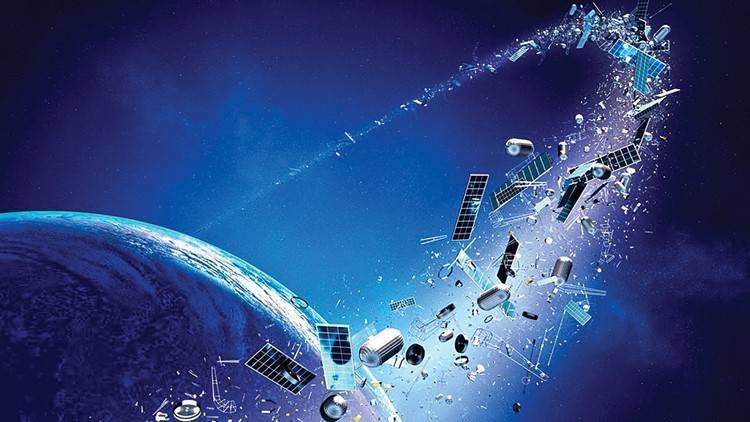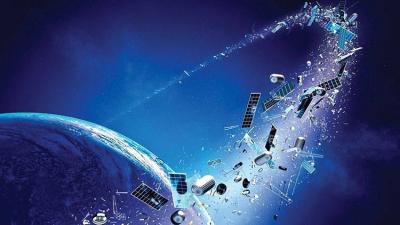The recent uncontrolled descent of a Chinese rocket, which wandered in space for several days before crashing into the Arabian Sea, has reignited discussions about the issue of space debris and the dangers it poses to inhabitants of Earth, as well as satellites and spacecraft. With the increasing number and size of these objects, scientists estimate that there are approximately 170 million pieces of debris orbiting Earth.
Space debris originates from rocket launches, satellites, or spacecraft in outer space. This debris can be large, such as a disabled satellite, or small, like parts of rockets or satellites and remnants of paint used on spacecraft. Additionally, there are pieces that have detached from spacecraft, fragments, and particles resulting from collisions or explosions in space, with some of this debris orbiting Earth at speeds of up to 36,000 kilometers per hour, while others drift in space. Since the beginning of human space travel in 1957, with the launch of the first satellite, "Sputnik," by the Soviet Union, this debris has accumulated significantly, resulting in a major problem.
Experts and space scientists liken pieces of space debris left by humans in low Earth orbit to a "floating plastic island" in outer space. According to experts at the 13th European Space Conference, space debris poses a real threat, similar to that posed by floating plastic islands in seas and oceans. For example, fragments of space debris measuring up to 1 cm can potentially destroy entire satellites. As of January 2019, there were over 5,000 satellites in space, but only 2,000 are still active, while 3,000 inactive satellites drift in space. Recent data indicates that there have been over 500 breakups or explosions of these space objects. Scientists warn that launching networks of satellites known as mega-constellations could lead to a phenomenon called "Kessler Syndrome," where a cascading interaction occurs, causing more objects to collide and create new space debris to the extent that Earth's orbit becomes unusable.
Japan plans to participate in cleaning space debris by launching a laser-powered satellite. Engineers have drawn inspiration for this satellite from a common technique used by dermatologists to remove skin blemishes, utilizing low-energy laser pulses designed for burning. Japan is set to launch this satellite in 2026, targeting small debris pieces that could potentially collide with active satellites. The satellite will weigh between 600 and 700 pounds and is expected to be placed in orbit between 350 and 600 miles above Earth, which will enable it to reach most of the estimated 170 million pieces of space debris, though fewer than 30,000 of these can be tracked, due to their high velocity of up to 27,000 kilometers per hour.
In a significant step toward addressing space debris, the European Space Agency previously announced the launch of a "capture robot," a prototype robotic device with four arms designed to embrace outdated satellites and take them to a "graveyard" in Earth's atmosphere for destruction. This mission is planned for 2025, and the robot will test its capabilities on a medium-sized piece of debris, leftover from a European Space Agency "Vega" rocket since 2013, located at an altitude of 800 km above Earth. This conical debris piece weighs approximately 100 kilograms, and the estimated cost of the mission is about 133 million dollars.
Among millions of pieces of space debris, there are some notable items, such as the glove that drifted away from the crew of "Gemini 4" during the first spacewalk conducted by American astronauts, and the camera lost by astronaut Michael Collins during the Gemini 10 mission.
A report published by the British "Daily Mail" revealed a list of countries responsible for space debris. According to the report from the British company "RS Components," which specializes in electronics, Russia tops the list with 14,403 pieces of debris, followed by the United States with 8,734 pieces, then China with 4,688, France with 994, and India with 517. The report indicates that there are more countries on the list, such as Germany and Britain, but the amount of space debris they have caused is minimal compared to other countries.
According to scientific estimates, there are approximately 170 million pieces of space debris orbiting Earth. According to NASA, over 128 million pieces of space debris are larger than 1 mm, 34,000 pieces are larger than 10 cm, and there are more than 20,000 pieces moving around Earth at speeds of up to 17,500 miles per hour, with 500,000 pieces the size of large rocks, in addition to millions of pieces of debris that cannot be tracked. The NASA Orbital Debris Program states that there are over 23,000 pieces of debris larger than 10 cm, with most of this debris circulating within about 1,250 miles of Earth's surface.
The duration of debris in space varies due to several factors, as Earth's gravity pulls many pieces into lower orbits until they enter the atmosphere, where the majority burn up upon re-entry. In contrast, some debris remains in orbit longer the higher its altitude. Space debris that moves in orbits below 600 kilometers typically returns to Earth within a few years, while debris at altitudes above 1,000 kilometers can remain in orbit for up to 100 years.
Space debris travels at extremely high speeds, and due to these speeds, small pieces of space debris measuring between 1 and 10 centimeters can penetrate and damage most spacecraft. A piece of space debris measuring ten centimeters long can cause damage equivalent to 25 sticks of dynamite, prompting NASA to establish a space monitoring network to avoid collisions with satellites or space shuttles.




